Bayon Temple: The Smiling Heart of Angkor Thom
If you’re heading to Siem Reap and planning to explore Angkor Wat, don’t stop there. One of the most unforgettable temples in the Angkor Archaeological Park – and arguably one of the most photogenic – is Bayon Temple. With its towering stone faces and mysterious charm, Bayon is often one of the highlights for any visitor to Siem Reap, and personally, it’s our favourite temple in the whole Angkor complex!
Whether you’re a history buff, a temple hopper, or just someone with a decent camera looking for some beautiful shots, you’d be making a big mistake if you didn’t check out Bayon Temple when you’re in Siem Reap!
What Is Bayon Temple?
Bayon Temple is the centerpiece of Angkor Thom, the last and most enduring capital city of the Khmer Empire. Built in the late 12th or early 13th century by King Jayavarman VII, Bayon stands out from the hundreds of other temples in Cambodia for one iconic reason: the beautiful stone faces – lots of them!
Over 200 massive faces are carved into the towers of Bayon, most of them believed to represent either the king himself or the Bodhisattva Avalokiteshvara, the Buddhist figure of compassion – though scholars still debate this. Each face wears a gentle smile and has half closed eyes, creating a peaceful, almost meditative atmosphere, even when you’re surrounded by crowds all trying to snap the same photo as you!
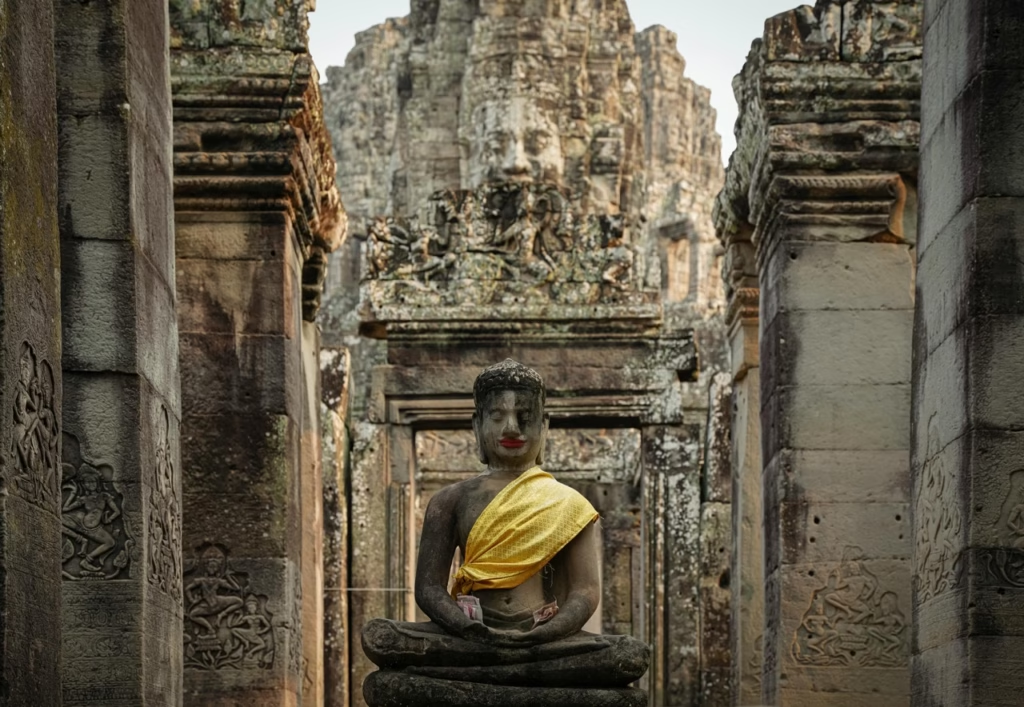
Bayon Temple vs Angkor Wat: What’s the Difference?
While Angkor Wat is known for its grand size, symmetrical layout, and Hindu design, Bayon is more maze-like and was built as a Buddhist temple (though it absorbed Hindu elements too due to modifications after the reign of Jayavarman VII).
Although Bayon Temple is often associated with Angkor Wat, it’s actually a separate temple located at the centre of Angkor Thom, within the Angkor Archaeological Park in Siem Reap. Bayon Temple stands out for its mysterious stone faces and less structured design. It’s one of the most popular temples included in the Angkor Wat short circuit tour, which typically features Bayon, Angkor Wat, and Ta Prohm (The Tomb Raider temple!) – making it a must see for temple hoppers with limited time in Siem Reap.
👉 YOU MIGHT LIKE : “The Complete Guide to Angkor Wat”
Top Things to See at Bayon Temple
The Smiling Stone Faces
Bayon Temple is most famous for its iconic stone faces – there are over 200 of them after all! Carved into the sides of the temple’s 54 towers, you’ll find four beautiful serene faces, looking out in every direction. No matter where you stand, it feels like one of them is watching you – but in a calm, reassuring way that adds to the temple’s charm.
Incredible Bas-Reliefs
Take a walk around the outer gallery and you’ll find some of the most detailed stone carvings in the Angkor Archaeological Park. These intricate bas-reliefs show everything from historical battles and religious rituals to scenes of everyday life in 12th-century Cambodia, including cockfighting, markets, and even people fishing. It’s like flipping through a stone graphic novel from 800 years ago.
The Upper Terrace
Don’t miss the climb to Bayon’s upper level, where you can get up close to the giant faces and explore the inner sanctuary. The upper terrace is full of narrow passageways, shadowy corners, and cool photo angles – perfect for a bit of temple adventuring. Just watch your step: the stairs are steep and worn, so good shoes and a bit of caution go a long way.
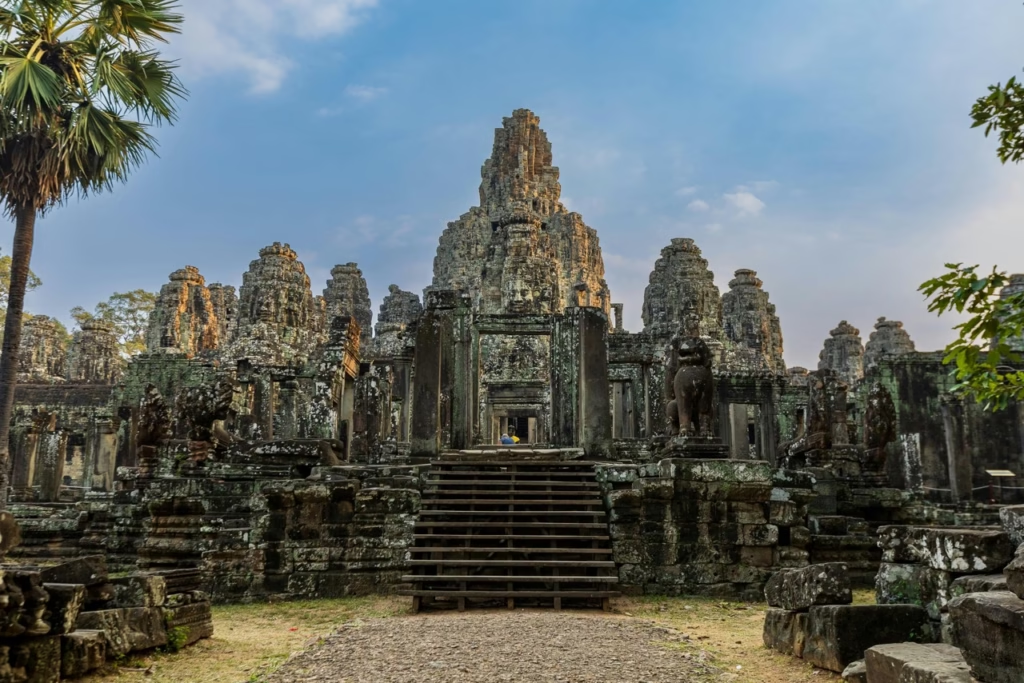
Travel Tips for Visiting Bayon Temple
🎟️ Entry Tickets
Bayon Temple is inside the Angkor Archaeological Park (the home of Angkor Wat!), so you’ll need a valid Angkor Pass. Prices as of 2025:
– 1 day pass: $37 USD
– 3 day pass: $62 USD
– 7 day pass: $72 USD
You can buy your pass with cash or card at the Angkor Ticket Center, about 4km from central Siem Reap. You can also purchase your Angkor Pass online, or at the kiosks in the Heritage Walk shopping mall.
For more information on Angkor Passes and Angkor Wat tickets, check out our article HERE.
🕒 Best Time to Visit
Bayon Temple is incredibly popular (understandably!), so it’s best to visit:
Early morning (7:30am – 9:00am) – before the large groups arrive, and while many people are still exploring Angkor Wat after watching the sunrise.
Late afternoon (3:30pm – 5:00pm) – when the light hits the faces beautifully and creates some awesome photo opportunities. Many people have also left the temple complex by this time and it’s a bit quieter, except for the popular sunset spots!
Avoid noon and the middle of the day if possible. Not only is it the hottest and sweatiest part of the day, but the lighting makes the carvings harder to see clearly and you won’t get as good photos!
The time of year is also important to consider!
👉 YOU MIGHT LIKE: “When is the best time to visit Cambodia?”
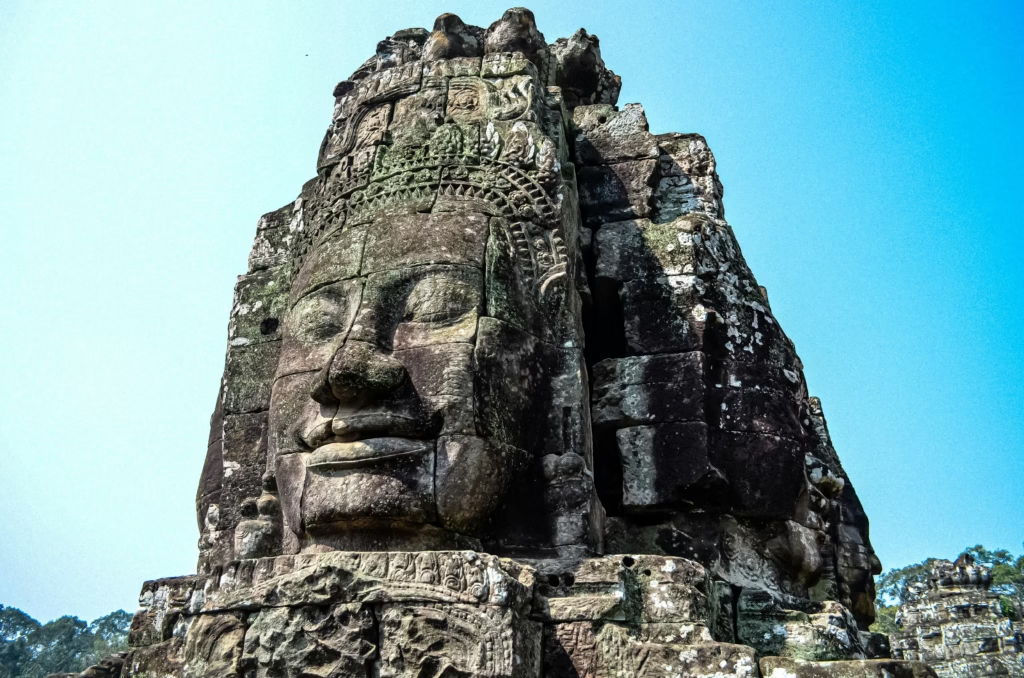
🚴 How to Get To Bayon Temple
Bayon is about 10-15 minutes from Angkor Wat by tuk-tuk. Most visitors include it as part of the Small Circuit tour (which also includes Ta Prohm, and Angkor Wat itself). You can hire a tuk-tuk for around $20–25 USD for the day to take you round the sites of the Angkor Archaeological park, but be aware that there’s so much on offer and one day might not be enough. We highly recommend going with a reputable guide instead of alone if it’s your first time, as not only will they get you around but they’ll also be able to offer you lots of useful information and local knowledge about the sites.
Feeling adventurous? You could rent a bicycle in Siem Reap (around $5-10/day) and cycle through the shady paths of Angkor Thom. It’s an amazing way to experience the area (as long as it’s not raining!). Thanks to recent infrastructure upgrades in Siem Reap, you can now get all the way from the Pub Street area to the Angkor Archaeological park via dedicated cycle paths.
What to Bring
- Water: It gets very hot in Siem Reap, especially around the temples (you may have seen us mention this in other articles if you have a keen eye) so make sure you stay hydrated while you’re visiting the area
- Sun protection: Hats, sunglasses, and sunscreen will help you avoid sunburn or being uncomfortable in the sun so you can enjoy your day
- Good shoes: You’ll be doing a lot of walking when you’re visiting Bayon temple or the surrounding sites, so make sure you’ve got comfortable shoes on. There is also a lot of areas where the ground can be uneven – last thing you want is to trip and fall!
- A camera or phone with space – You can be sure you’ll take a lot of pictures of the beautiful faces at Bayon Temple, even if you’re not a photographer. Make sure you’ve got plenty of space on your phone or camera and it’s fully charged!
You might also want to bring some bug spray if you’re a particularly tasty treat for mosquitos or ants!
What to Wear at Angkor Wat and Bayon Temple
Bayon Temple, and the Angkor Archaeological Park in general have the same requirements for what you should be wearing. As a sacred religious site in a modest Buddhist country, make sure you’re dressing appropriately in order to be respectful to the local culture. This means making sure your shoulders and knees are covered by your clothing, and you’re not wearing anything revealing or disrespectful. If you don’t have the right clothing and you’re caught short, there are places at the market within the archeological park where you can buy things like elephant pants or sarongs at a reasonable price to cover up.
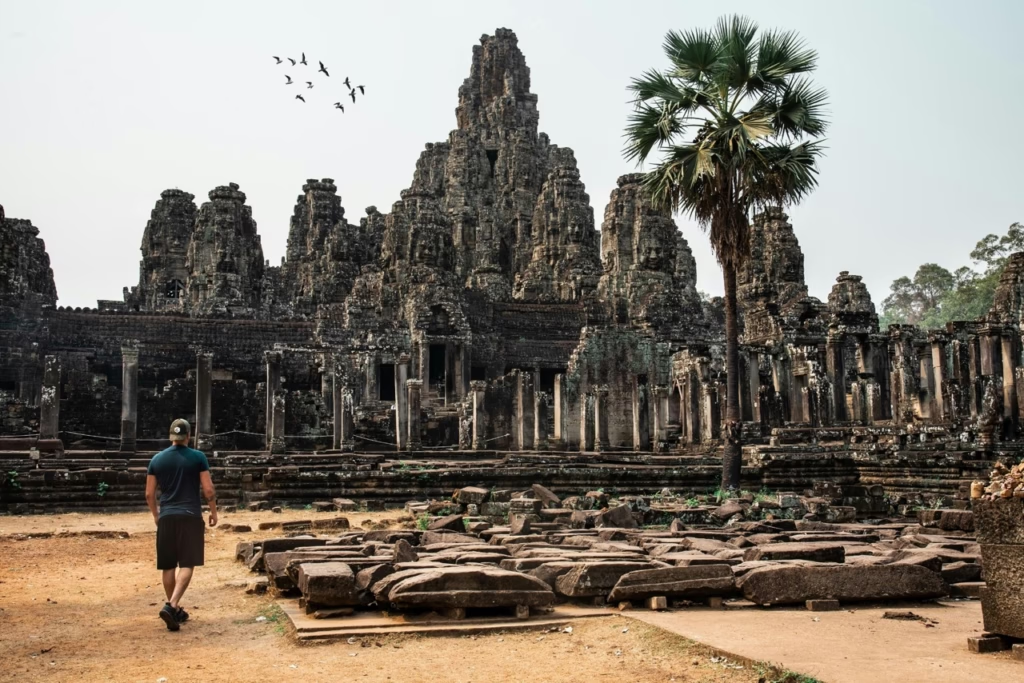
Quick Fun Facts
– Bayon’s 54 towers of faces are thought to be arranged in a way that reflects Mahayana Buddhist cosmology, with some scholars suggesting the layout may represent a symbolic mandala
– Much like many of the structures in the Angkor Archaeological Park, Bayon Temple was built on top of older structures – you can still see remnants of earlier buildings below in some places
– The exact number of faces at Bayon is debated. While some suggest there were originally 216 (four on each of the 54 towers), others argue that the number is lower today due to weathering, damage, and collapse over time. If I still looked that good after 800 years, I can’t say I’d be complaining!
Nearby Hidden Gem Temples to Check Out
If you’re visiting Bayon Temple, it’s well worth exploring the nearby highlights within Angkor Thom, the ancient walled city at the heart of the Angkor Archaeological Park. Just a short walk from Bayon Temple, you’ll find Baphuon, a towering sandstone temple-mountain known for its steep climb and the giant reclining Buddha hidden on its back wall. A few minutes away is the Terrace of the Elephants, an impressive platform once used for royal ceremonies and now a favourite photo spot for visitors. The image below was taken during a traditional Khmer clothing photoshoot at the Terrace of the Elephants!
Another must see in the area is Phimeanakas, a smaller but historically significant temple set inside the former Royal Palace grounds. Together, these temples make for a fantastic half-day walking adventure from Bayon and offer a deeper look into the intricacies of Angkor Thom beyond the iconic stone faces.
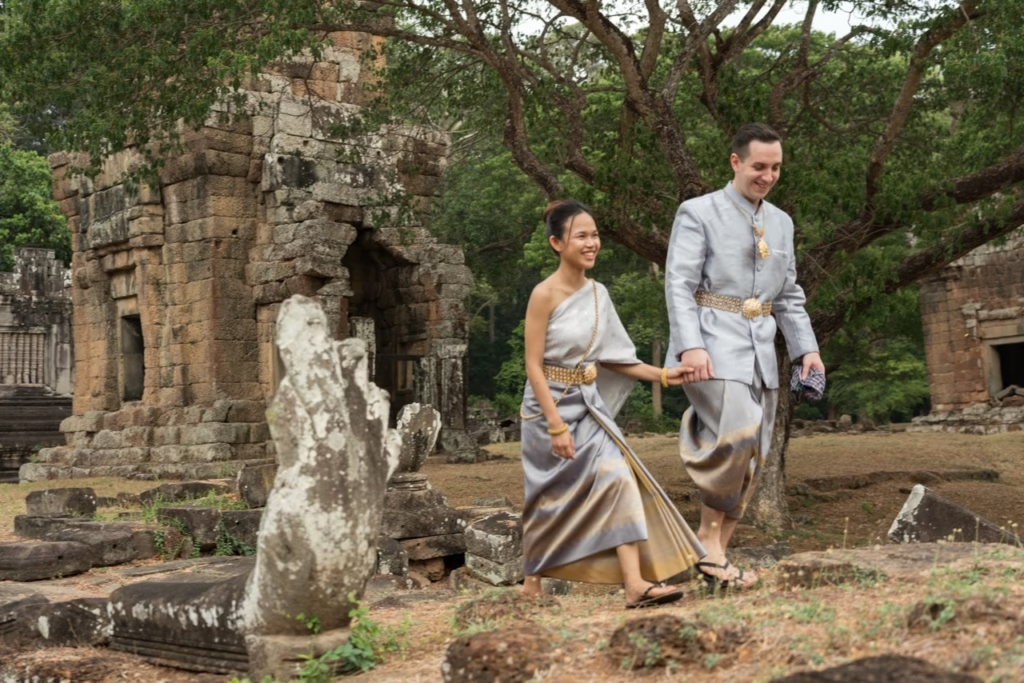
Is Bayon Temple Worth Visiting?
Without a doubt, Bayon Temple is one of the most fascinating and unforgettable sites in the entire Angkor complex. Personally, it’s my favourite temple, and the one that I can spend the most time enjoying. I make a point of visiting as often as I can with my Angkor Wat Pass for Residents. The mysterious smiling stone faces and intricate carvings offer a completely different vibe to Angkor Wat, making it a must-see for anyone visiting Siem Reap in our opinion.
👉 YOU MIGHT LIKE : Free Angkor Wat Pass for Residents
Whether you’re visiting for the ancient history, architecture, or just want some stunning photos, Bayon is where you want to be. It’s also easily accessible as part of the Angkor Wat short circuit tour and well worth including on your itinerary – you won’t regret it!
For more great information or recommendations from our Siem Reap travel guide and for tips on Cambodia in general, don’t forget to follow our Instagram, Facebook, YouTube and TikTok accounts for regular fun and updates!
@morethantemples
Thinking about a trip to Cambodia and looking for someone to help plan your itinerary, or just looking for someone to take you to places you won’t find on regular tours? CLICK HERE to visit our “Tours” page and get in touch. Nightlife tours also available!
Any information in the article above was correct at the time of posting to the best of our knowledge. If you notice any issues or would like to chat to us about the article please get in touch with us via our “ABOUT” page. If you’re the owner of a business we’ve written about and would like to discuss any out of date or incorrect information, please get in touch and we’ll be more than happy to help! Any opinions expressed in our articles are our own and may not be representative of everyone’s experience.
If you found this article helpful, please consider heading to our ABOUT page by CLICKING HERE, and leaving us a tip via BuyMeACoffee!



